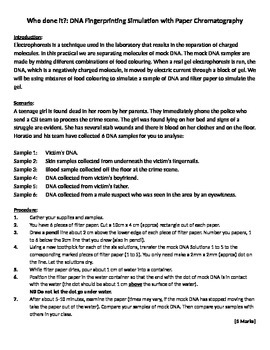

- Example of a lab report file digital forensics how to#
- Example of a lab report file digital forensics android#
- Example of a lab report file digital forensics download#
In Santoku, following is the location for all the AVDs created. Once you create an emulator, navigate to its location on your file system. Emulating “user data” taken from a real device:Ĭreate a new emulator once again by following the same steps but “ do not start” it.
Example of a lab report file digital forensics how to#
So let’s see how to create an AVD with custom data partition taken from a real device for performing further analysis.

Note: The device we just created merely contains nothing interesting inside its internal storage for forensic analysis purposes. Once it is started, you should see an emulator as shown below.Ĭongratulations! You have created your emulator with the specification of your choice. You should see the following confirmation dialogue.Ĭlick “Launch” and it starts the emulator showing the following progress bar.īe patient and wait for a while as the emulator may take a longer time to launch when you do it for the first time. Once if you are done with the steps shown, you should see an additional Virtual Device as shown below.Ĭhoose the newly created emulator and click “Start” button to start the emulator. If you have done everything, you should see the following window after choosing everything properly.Ĭlick “OK” and you should see the following confirmation dialogue.Ĭross check everything and click “OK” to complete the setup. SD Card image location: ” ~/Desktop/files/sdcard.img”Ĭlick “Browse” in the above window to choose the SD Card image and choose it from the location mentioned above as shown in the figure below. The image is provided in the VM at the following location.
Example of a lab report file digital forensics android#
In the case, we are going to choose an SD Card image taken from a real Android device. Finally, we need to provide SD Card options. Then, we chose to have “Android 4.4.2-API Level 19” as our target. Now, let’s choose the appropriate options as shown below.Īs you can see in the above figure, we have named our emulator “suspect_device.” Then, we chose a device with “3.2-inch HVGA” to have an emulator with the smaller size. Now, let’s create a new emulator with the specifications of our choice.Ĭlick “Create” and you should see the following window. This will open up “Android Virtual Device(AVD) Manager” window as shown below.Īs you can see in the above figure, we already have one emulator configured. Once if everything is set, click “Tools” in the menu bar at the top of the window and then click “Manage AVDs” as shown below. If you notice the above figure, we have already installed “Android 4.4.2 ARM EABI v7a System Image” for this reason. So, we are going to create an appropriate emulator that can mount this image (Android version >= 4.1.1). In a later section, we will mount an image taken from a real device running Android 4.1.1.
Example of a lab report file digital forensics download#
Depending on the case and Android version of your target device, we should download Android images to create an appropriate emulator. The above step will open up the following window.īy default, Santoku consists of images of only a few Android versions. Navigate to “Santoku->Development Tools” and Click “Android SDK Manager”. Steps to set up an Android Virtual Device:Īs mentioned, we will begin this exercise by creating an emulator. List of VMs used: This lab exercise makes use of Santoku Linux VM.įiles used in this lab: sdcard.img, image.img


 0 kommentar(er)
0 kommentar(er)
